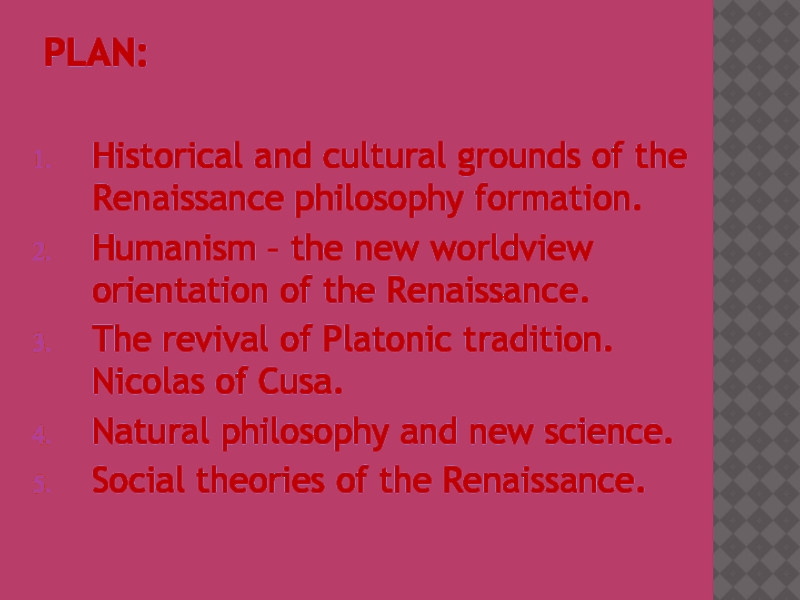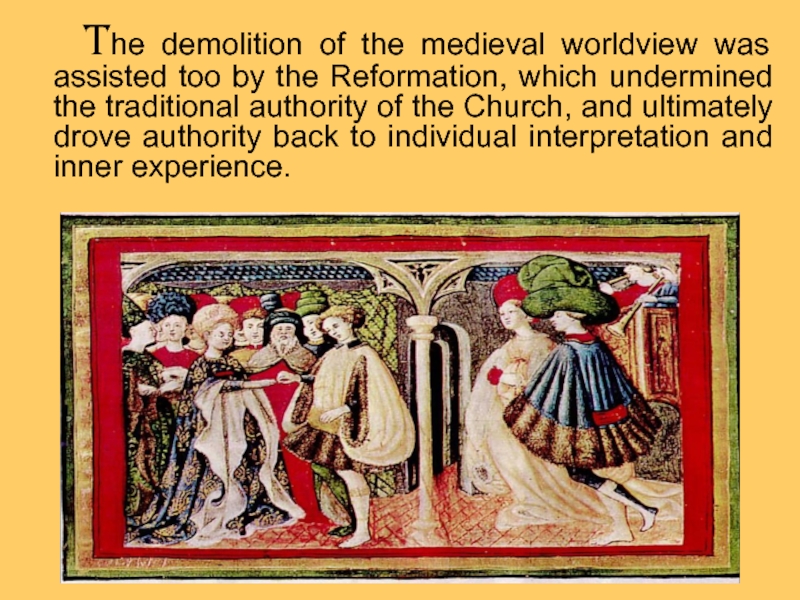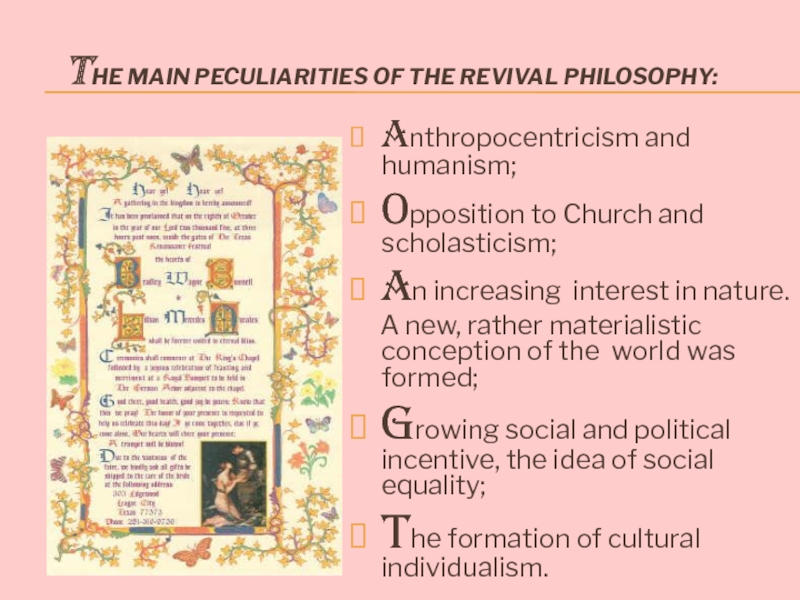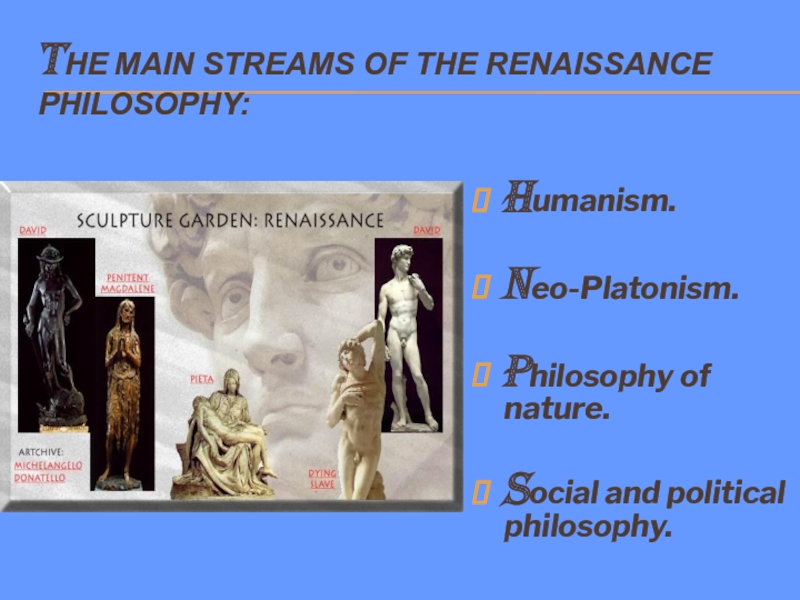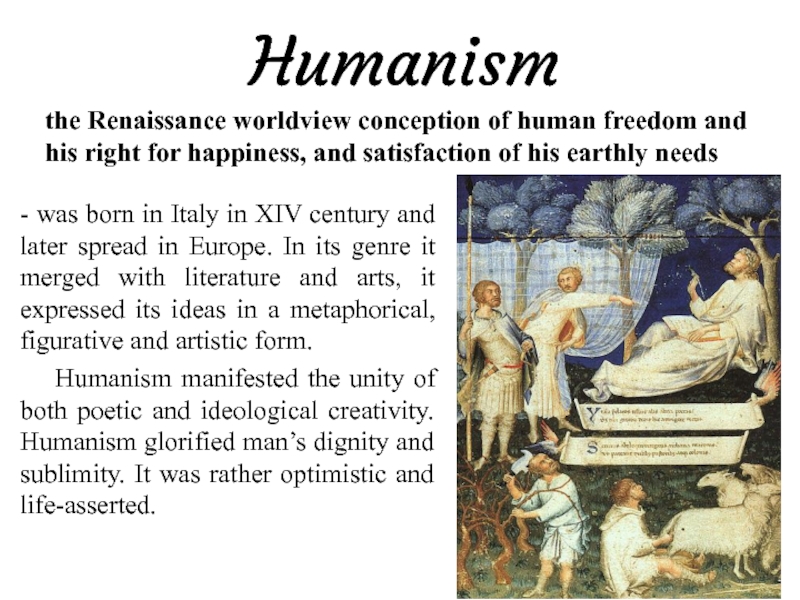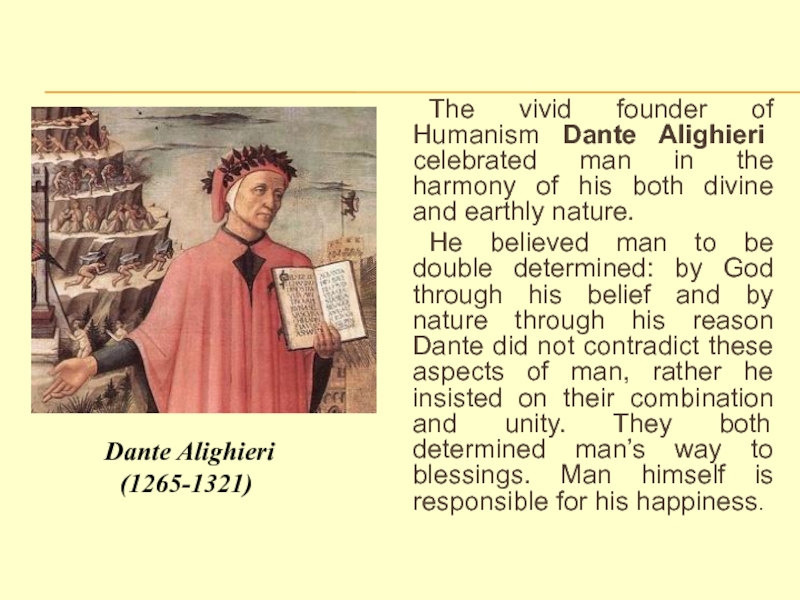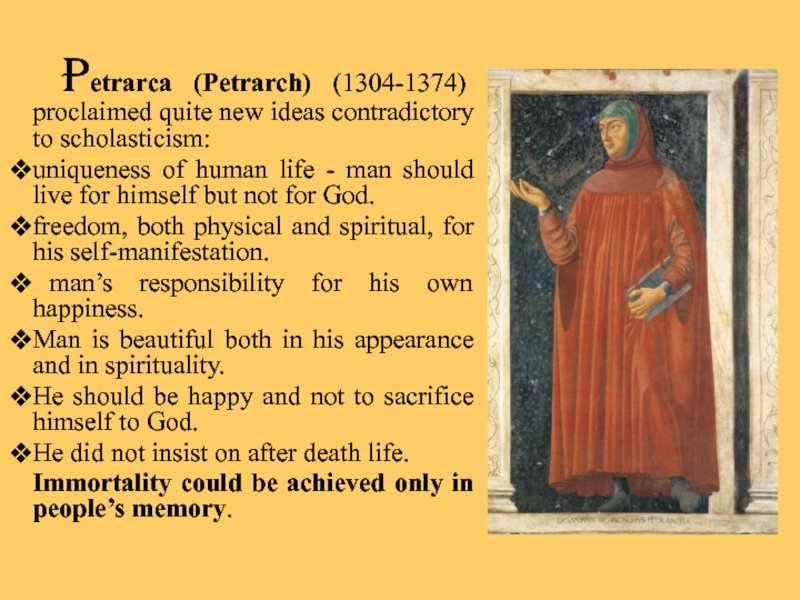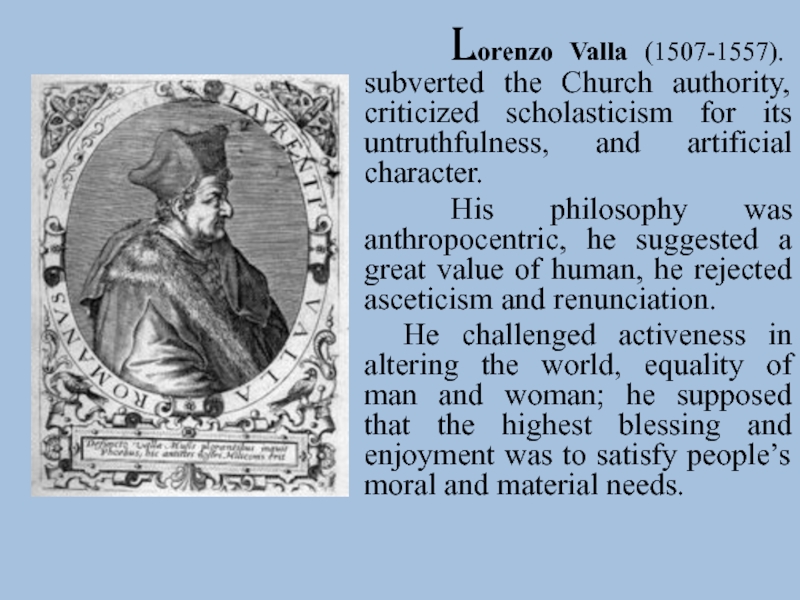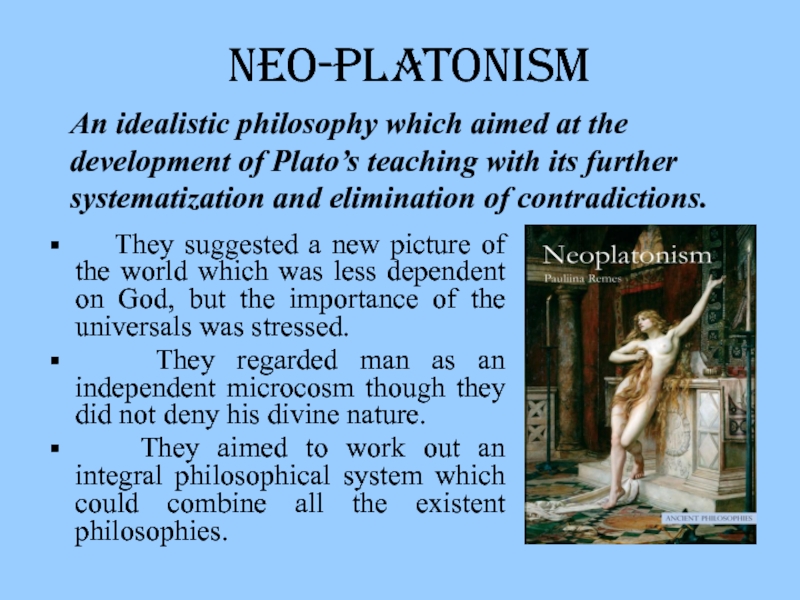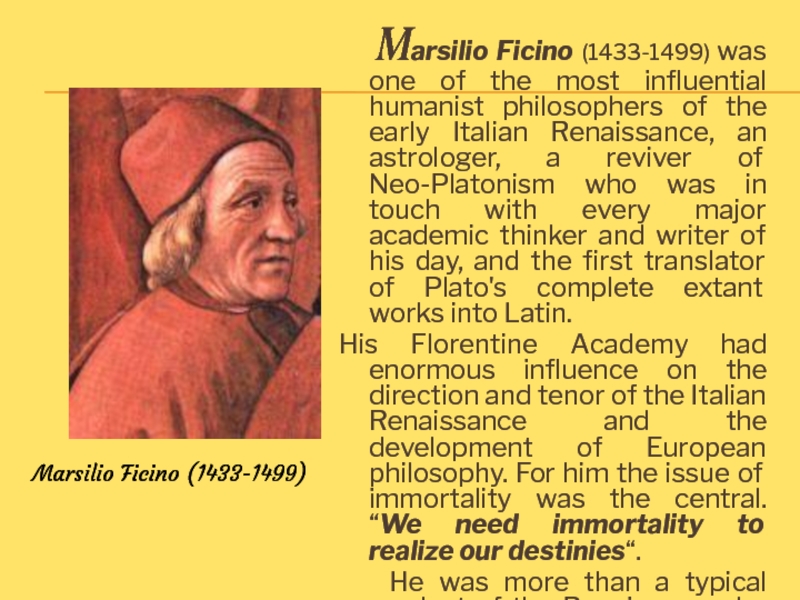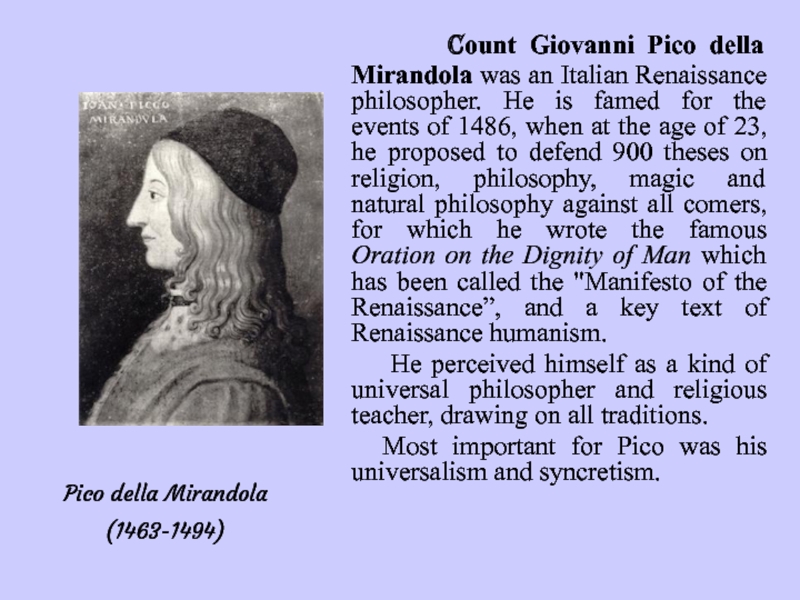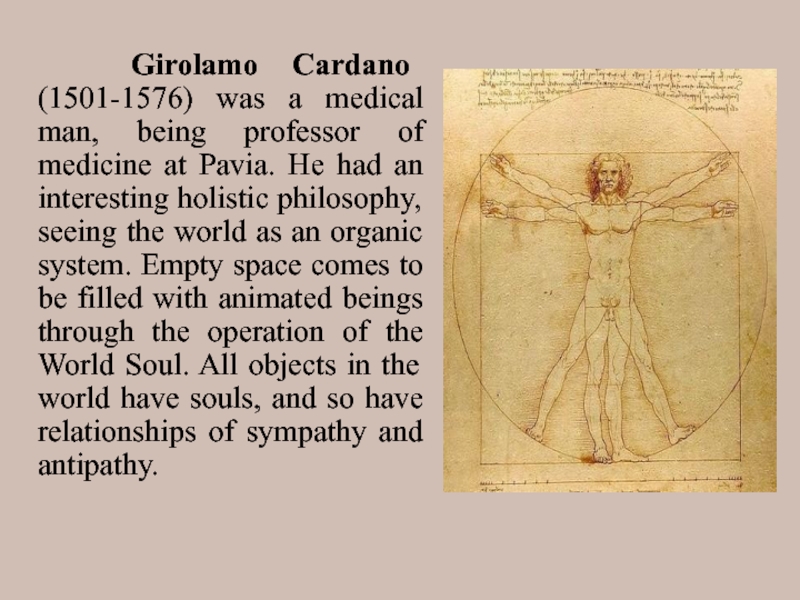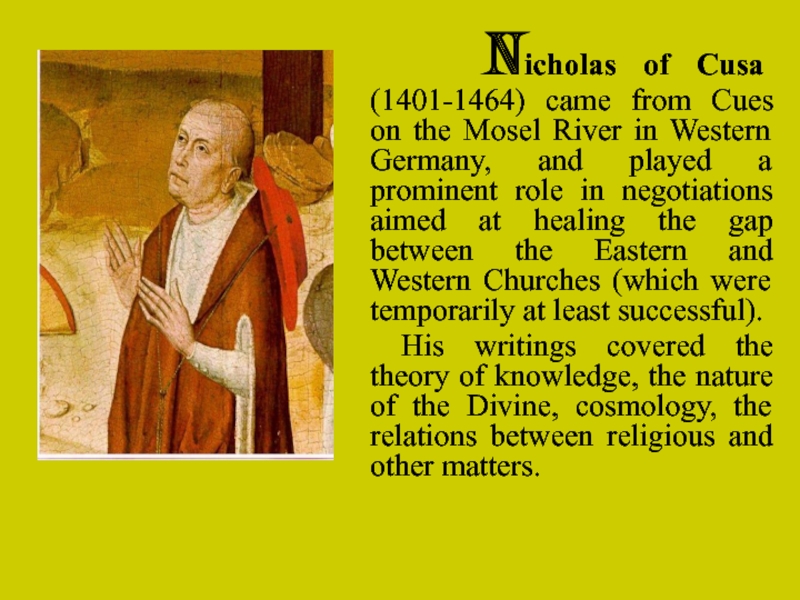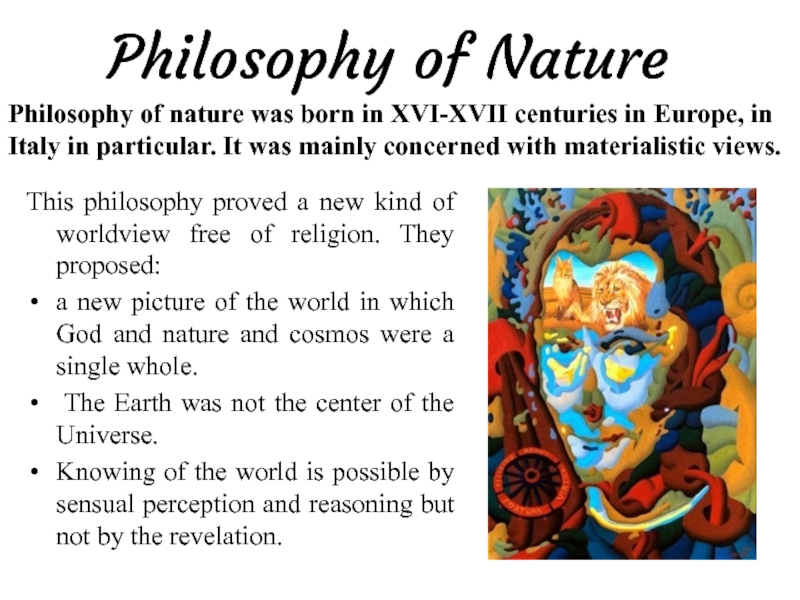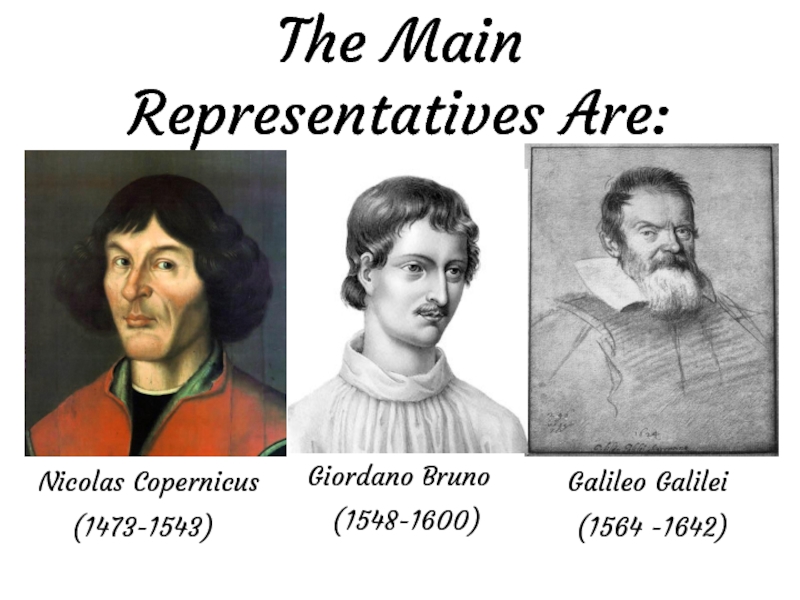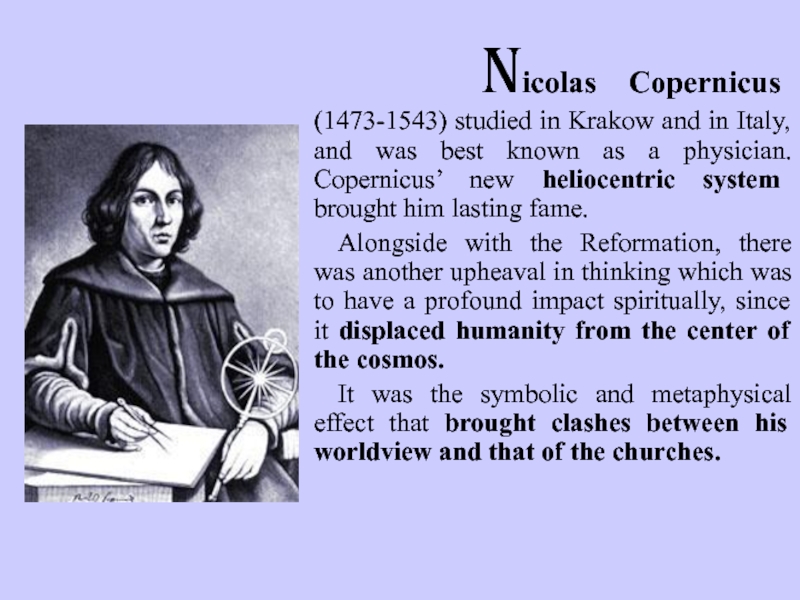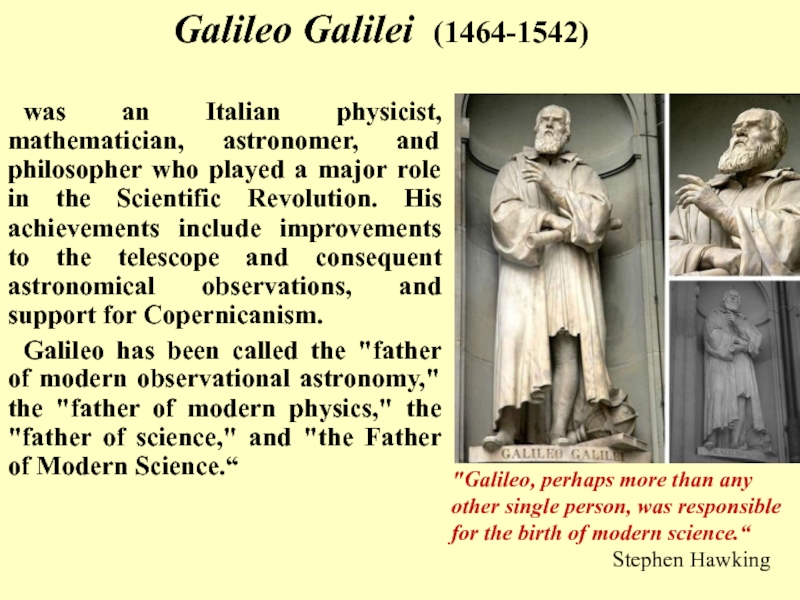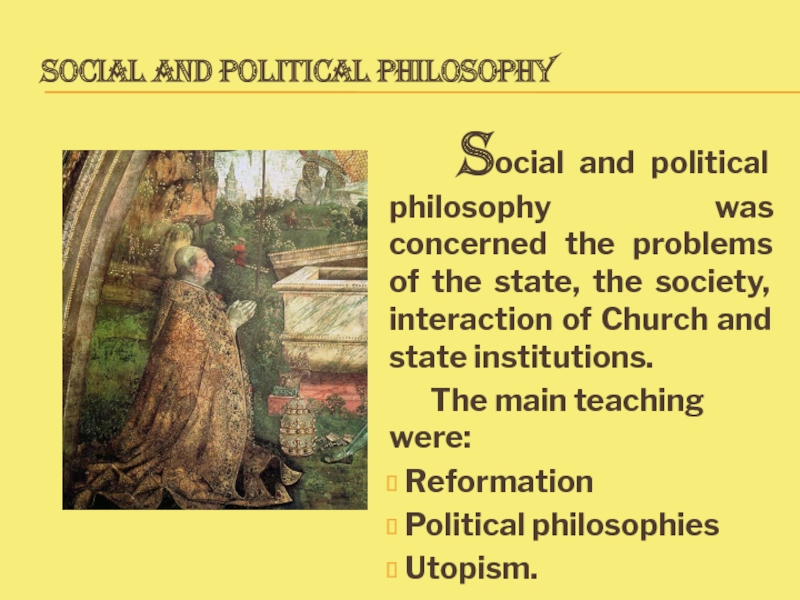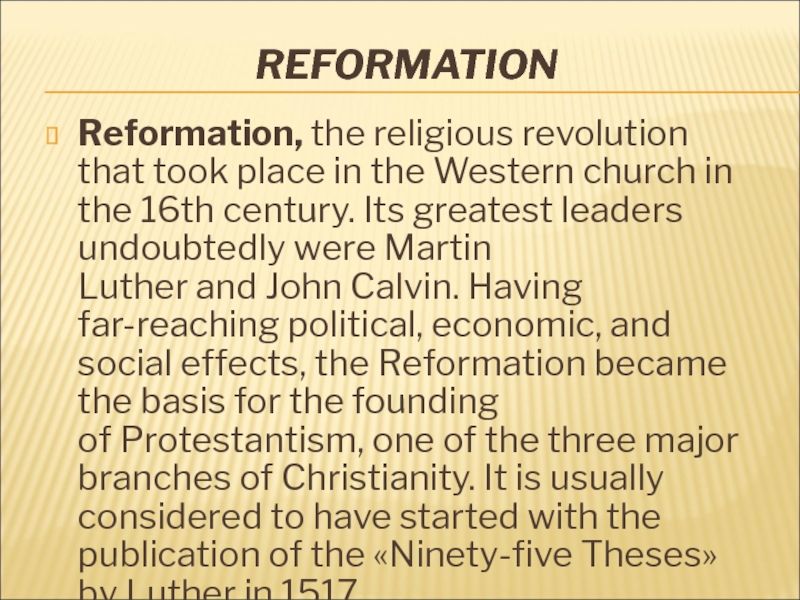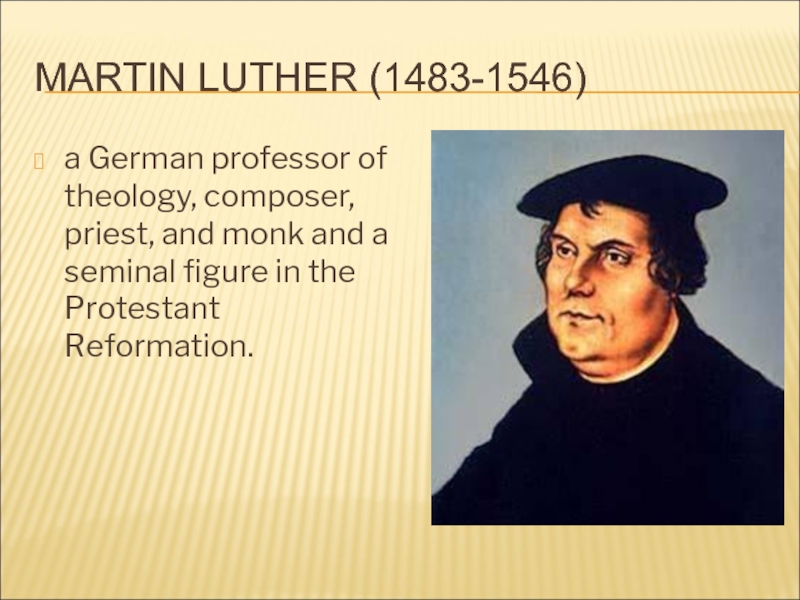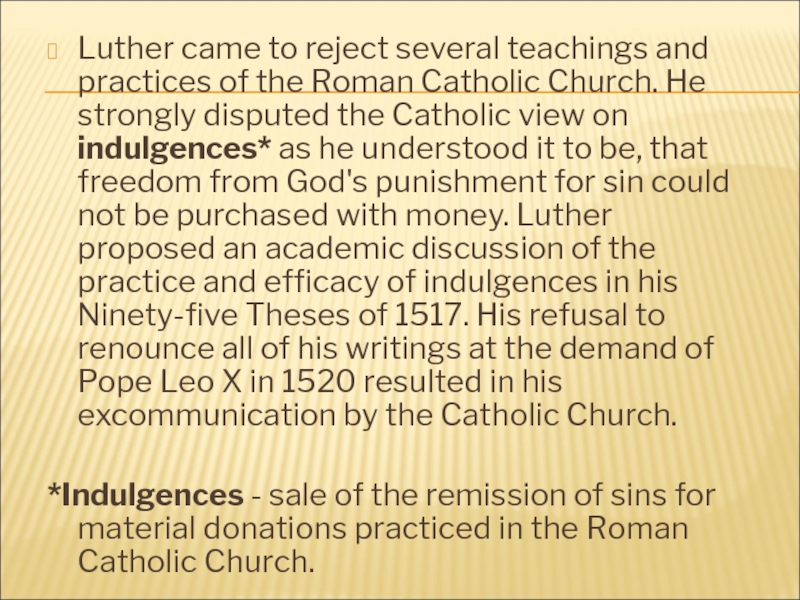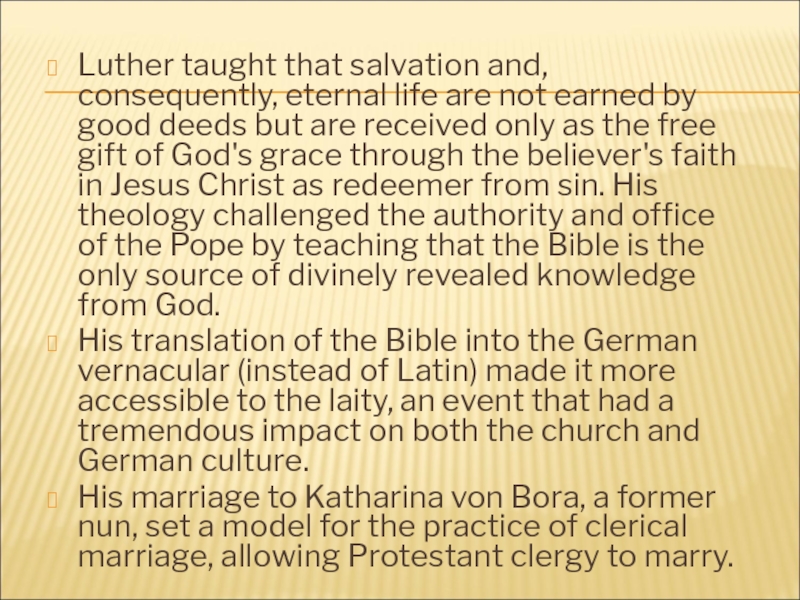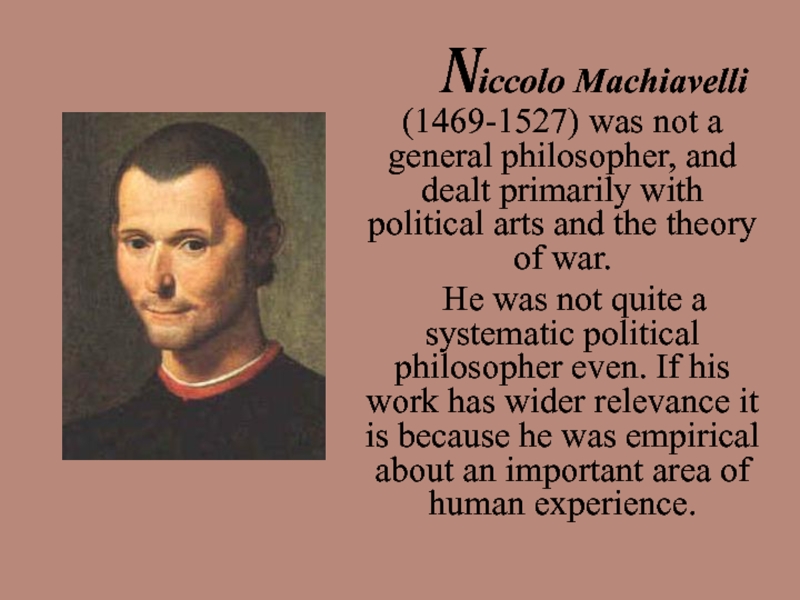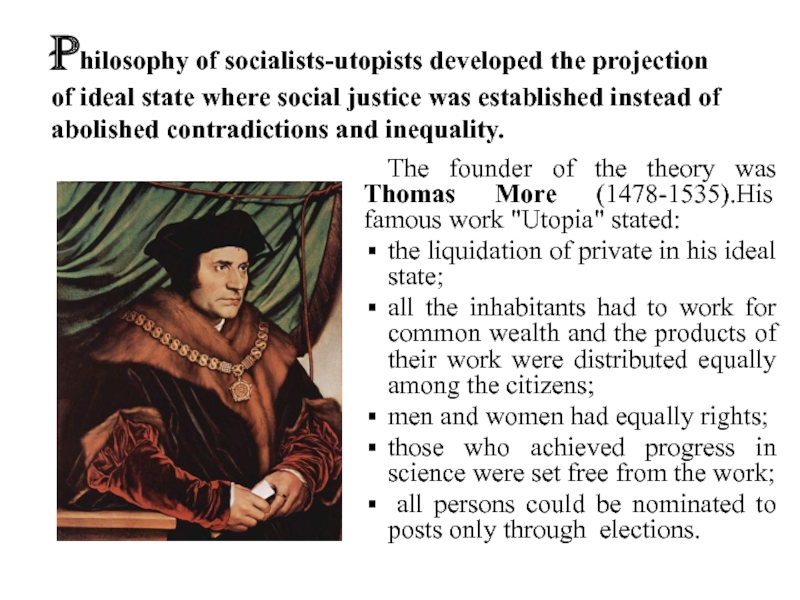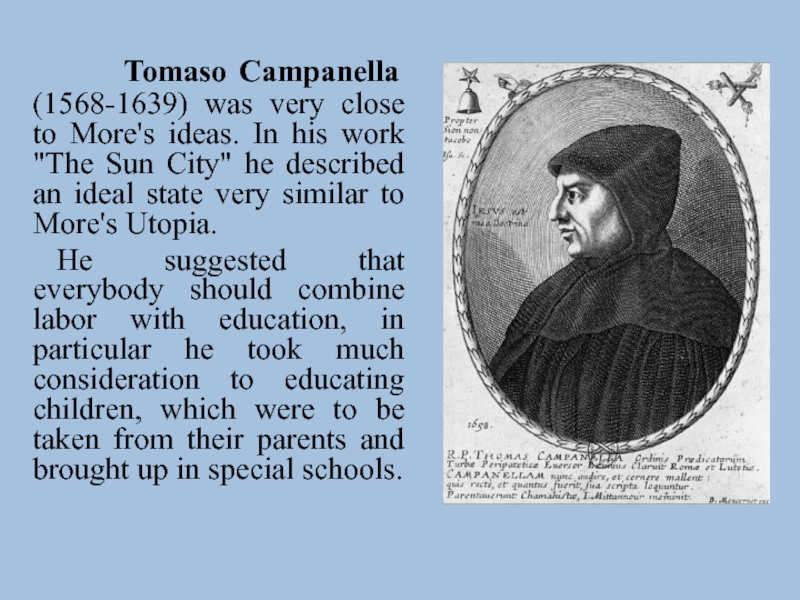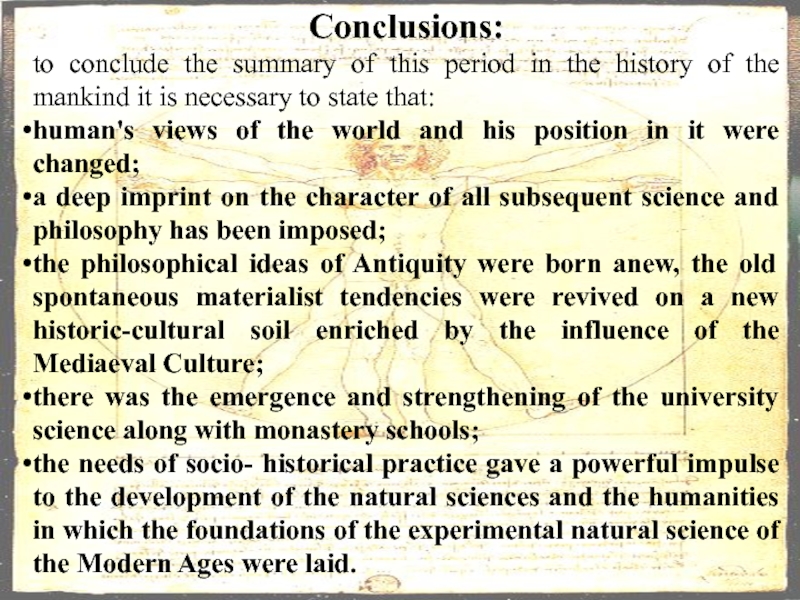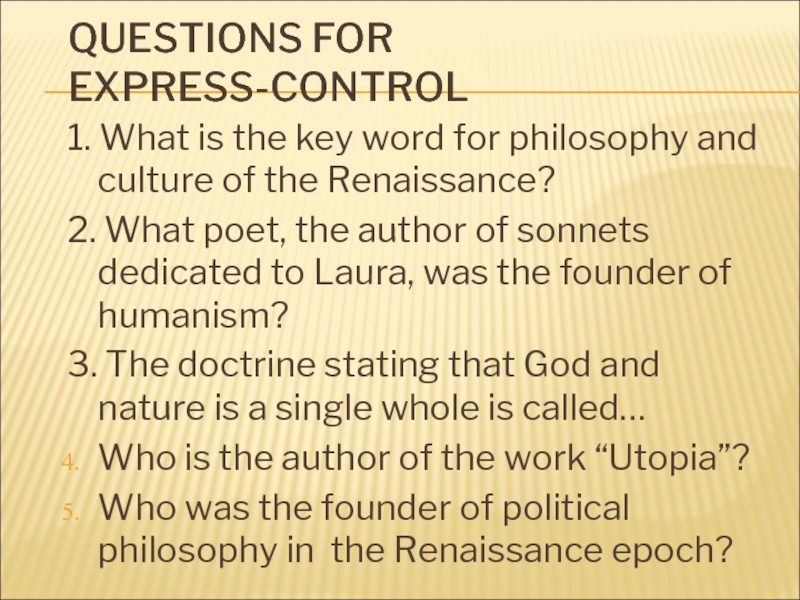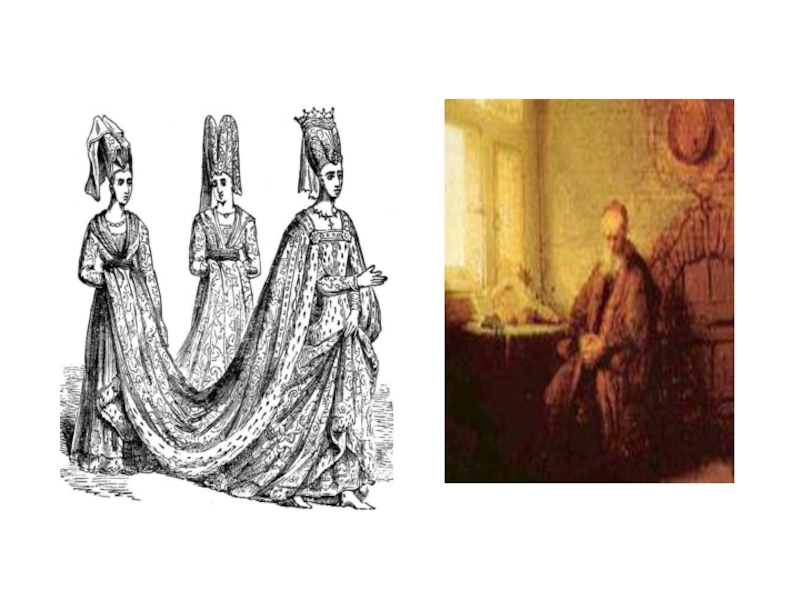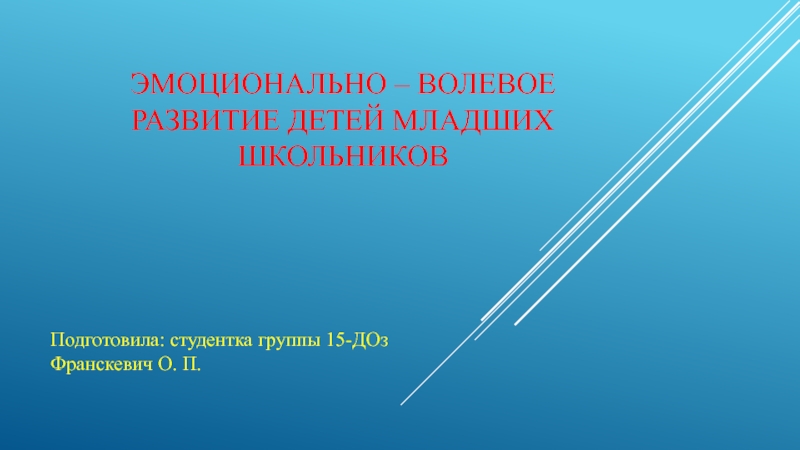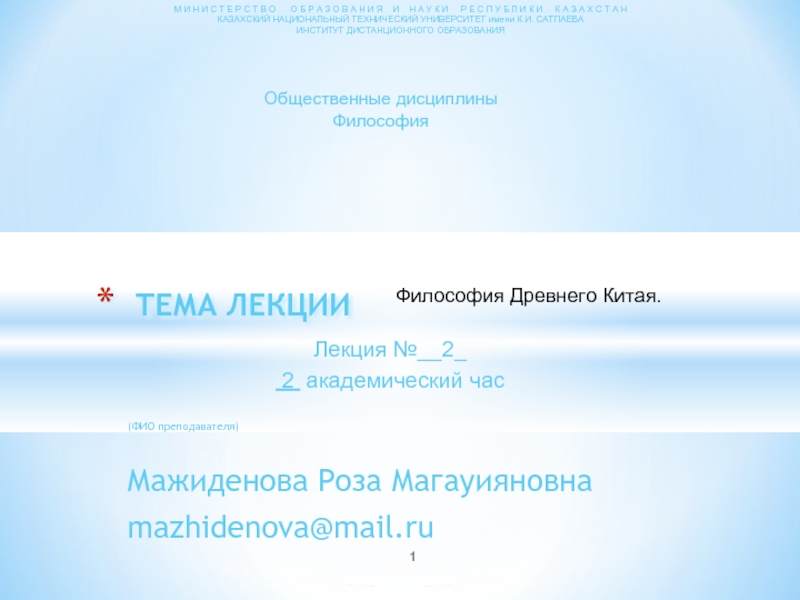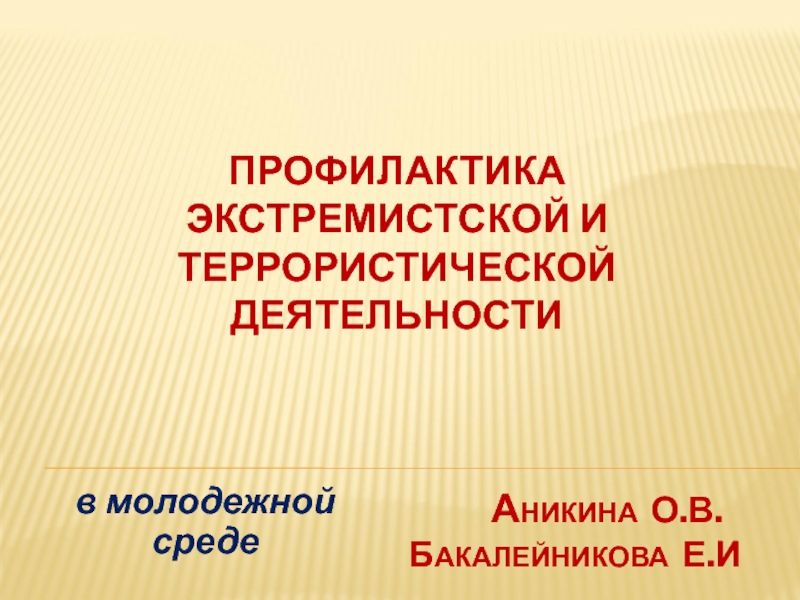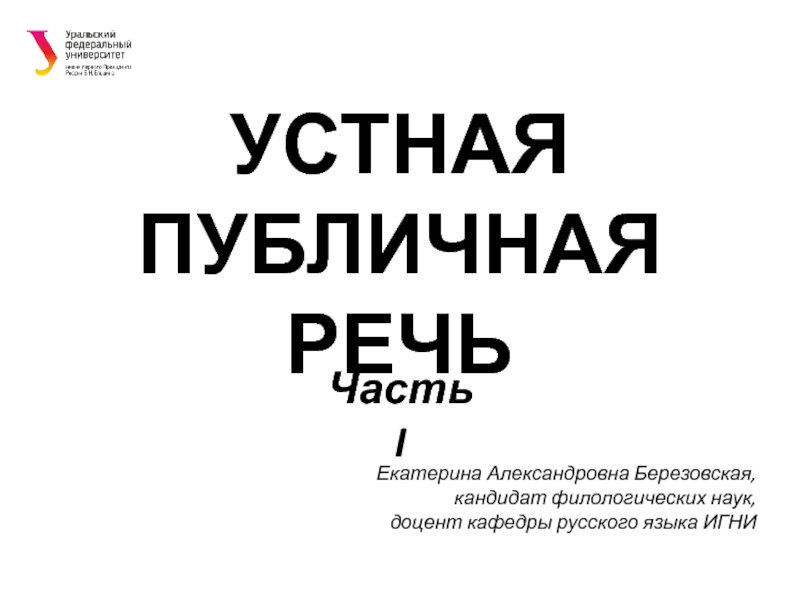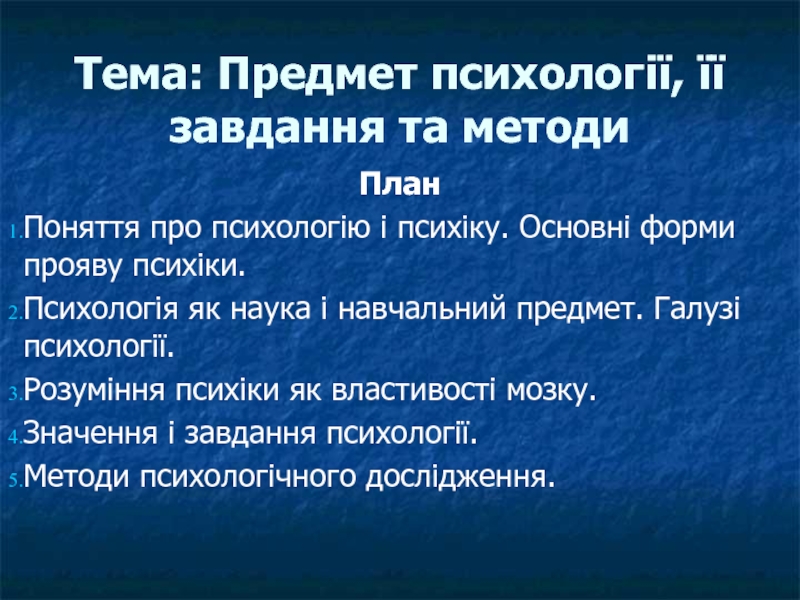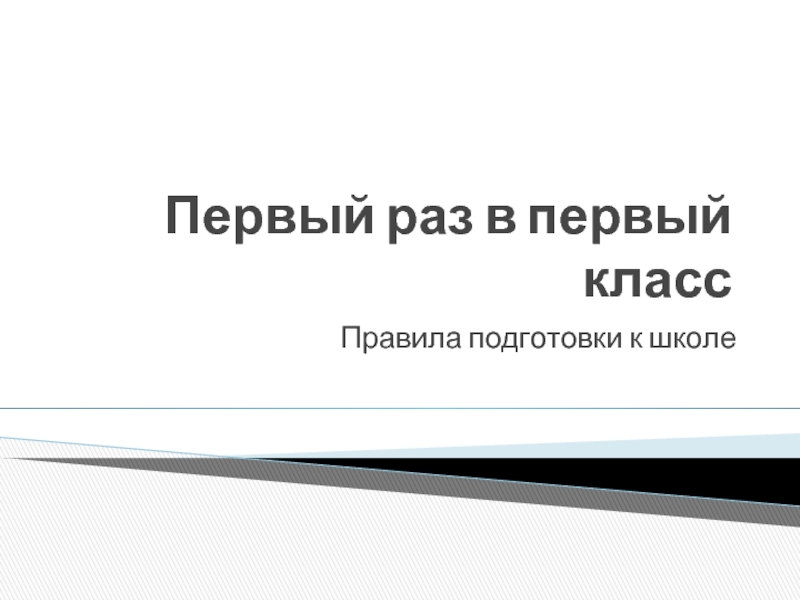- Главная
- Разное
- Дизайн
- Бизнес и предпринимательство
- Аналитика
- Образование
- Развлечения
- Красота и здоровье
- Финансы
- Государство
- Путешествия
- Спорт
- Недвижимость
- Армия
- Графика
- Культурология
- Еда и кулинария
- Лингвистика
- Английский язык
- Астрономия
- Алгебра
- Биология
- География
- Детские презентации
- Информатика
- История
- Литература
- Маркетинг
- Математика
- Медицина
- Менеджмент
- Музыка
- МХК
- Немецкий язык
- ОБЖ
- Обществознание
- Окружающий мир
- Педагогика
- Русский язык
- Технология
- Физика
- Философия
- Химия
- Шаблоны, картинки для презентаций
- Экология
- Экономика
- Юриспруденция
The Philosophy of the Renaissance презентация
Содержание
- 1. The Philosophy of the Renaissance
- 2. PLAN: Historical and cultural grounds of
- 3. The demolition of the medieval
- 4. Anthropocentricism and humanism; Opposition to Church
- 5. THE MAIN STREAMS OF THE RENAISSANCE PHILOSOPHY:
- 6. Humanism - was born in
- 7. The vivid founder of Humanism
- 8. Petrarca (Petrarch) (1304-1374) proclaimed quite new
- 9. Lorenzo Valla (1507-1557). subverted the Church
- 10. Neo-Platonism
- 11. Marsilio Ficino (1433-1499)
- 12. Count Giovanni Pico della Mirandola
- 13. Girolamo Cardano (1501-1576) was a
- 14. Nicholas of Cusa (1401-1464) came from
- 15. Philosophy of Nature This philosophy proved
- 16. The Main Representatives Are: Nicolas Copernicus
- 17. Nicolas Copernicus (1473-1543) studied in
- 18. was an Italian physicist, mathematician,
- 19. SOCIAL AND POLITICAL PHILOSOPHY Social and
- 20. REFORMATION Reformation, the religious revolution that took place
- 21. MARTIN LUTHER (1483-1546) a German professor of
- 22. Luther came to reject several teachings and
- 23. Luther taught that salvation and, consequently, eternal
- 24. Niccolo Machiavelli (1469-1527) was not
- 25. The founder of the theory was Thomas
- 26. Tomaso Campanella (1568-1639) was very
- 27. Conclusions: to conclude the summary of
- 28. QUESTIONS FOR EXPRESS-CONTROL 1. What is the
Слайд 2PLAN:
Historical and cultural grounds of the Renaissance philosophy formation.
Humanism – the
The revival of Platonic tradition. Nicolas of Cusa.
Natural philosophy and new science.
Social theories of the Renaissance.
Слайд 3 The demolition of the medieval worldview was assisted too
Слайд 4Anthropocentricism and humanism;
Opposition to Church and scholasticism;
An increasing interest in
A new, rather materialistic conception of the world was formed;
Growing social and political incentive, the idea of social equality;
The formation of cultural individualism.
THE MAIN PECULIARITIES OF THE REVIVAL PHILOSOPHY:
Слайд 5THE MAIN STREAMS OF THE RENAISSANCE PHILOSOPHY:
Humanism.
Neo-Platonism.
Philosophy of nature.
Social and political
Слайд 6 Humanism
- was born in Italy in XIV century and
Humanism manifested the unity of both poetic and ideological creativity. Humanism glorified man’s dignity and sublimity. It was rather optimistic and life-asserted.
the Renaissance worldview conception of human freedom and his right for happiness, and satisfaction of his earthly needs
Слайд 7
The vivid founder of Humanism Dante Alighieri celebrated man in
He believed man to be double determined: by God through his belief and by nature through his reason Dante did not contradict these aspects of man, rather he insisted on their combination and unity. They both determined man’s way to blessings. Man himself is responsible for his happiness.
Dante Alighieri (1265-1321)
Слайд 8 Petrarca (Petrarch) (1304-1374) proclaimed quite new ideas contradictory to scholasticism:
uniqueness of human life - man should live for himself but not for God.
freedom, both physical and spiritual, for his self-manifestation.
man’s responsibility for his own happiness.
Man is beautiful both in his appearance and in spirituality.
He should be happy and not to sacrifice himself to God.
He did not insist on after death life.
Immortality could be achieved only in people’s memory.
Слайд 9 Lorenzo Valla (1507-1557). subverted the Church authority, criticized scholasticism for
His philosophy was anthropocentric, he suggested a great value of human, he rejected asceticism and renunciation.
He challenged activeness in altering the world, equality of man and woman; he supposed that the highest blessing and enjoyment was to satisfy people’s moral and material needs.
Слайд 10Neo-Platonism
They suggested a new
They regarded man as an independent microcosm though they did not deny his divine nature.
They aimed to work out an integral philosophical system which could combine all the existent philosophies.
An idealistic philosophy which aimed at the development of Plato’s teaching with its further systematization and elimination of contradictions.
Слайд 11
Marsilio Ficino (1433-1499) was one of the most
His Florentine Academy had enormous influence on the direction and tenor of the Italian Renaissance and the development of European philosophy. For him the issue of immortality was the central. “We need immortality to realize our destinies“.
He was more than a typical product of the Renaissance: he was a major symbol of it.
Marsilio Ficino (1433-1499)
Слайд 12 Count Giovanni Pico della Mirandola was an Italian Renaissance
He perceived himself as a kind of universal philosopher and religious teacher, drawing on all traditions.
Most important for Pico was his universalism and syncretism.
Pico della Mirandola
(1463-1494)
Слайд 13 Girolamo Cardano (1501-1576) was a medical man, being professor
Слайд 14 Nicholas of Cusa (1401-1464) came from Cues on the Mosel
His writings covered the theory of knowledge, the nature of the Divine, cosmology, the relations between religious and other matters.
Слайд 15Philosophy of Nature
This philosophy proved a new kind of worldview
a new picture of the world in which God and nature and cosmos were a single whole.
The Earth was not the center of the Universe.
Knowing of the world is possible by sensual perception and reasoning but not by the revelation.
Philosophy of nature was born in XVI-XVII centuries in Europe, in Italy in particular. It was mainly concerned with materialistic views.
Слайд 16The Main Representatives Are:
Nicolas Copernicus
(1473-1543)
Galileo
(1564 -1642)
Giordano Bruno
(1548-1600)
Слайд 17 Nicolas Copernicus (1473-1543) studied in Krakow and in Italy,
Alongside with the Reformation, there was another upheaval in thinking which was to have a profound impact spiritually, since it displaced humanity from the center of the cosmos.
It was the symbolic and metaphysical effect that brought clashes between his worldview and that of the churches.
Слайд 18
was an Italian physicist, mathematician, astronomer, and philosopher who played a
Galileo has been called the "father of modern observational astronomy," the "father of modern physics," the "father of science," and "the Father of Modern Science.“
"Galileo, perhaps more than any other single person, was responsible for the birth of modern science.“
Stephen Hawking
Galileo Galilei (1464-1542)
Слайд 19SOCIAL AND POLITICAL PHILOSOPHY
Social and political philosophy was concerned the
The main teaching were:
Reformation
Political philosophies
Utopism.
Слайд 20REFORMATION
Reformation, the religious revolution that took place in the Western church in the 16th
Слайд 21MARTIN LUTHER (1483-1546)
a German professor of theology, composer, priest, and monk
Слайд 22Luther came to reject several teachings and practices of the Roman
*Indulgences - sale of the remission of sins for material donations practiced in the Roman Catholic Church.
Слайд 23Luther taught that salvation and, consequently, eternal life are not earned
His translation of the Bible into the German vernacular (instead of Latin) made it more accessible to the laity, an event that had a tremendous impact on both the church and German culture.
His marriage to Katharina von Bora, a former nun, set a model for the practice of clerical marriage, allowing Protestant clergy to marry.
Слайд 24 Niccolo Machiavelli (1469-1527) was not a general philosopher, and
He was not quite a systematic political philosopher even. If his work has wider relevance it is because he was empirical about an important area of human experience.
Слайд 25The founder of the theory was Thomas More (1478-1535).His famous work
the liquidation of private in his ideal state;
all the inhabitants had to work for common wealth and the products of their work were distributed equally among the citizens;
men and women had equally rights;
those who achieved progress in science were set free from the work;
all persons could be nominated to posts only through elections.
Philosophy of socialists-utopists developed the projection of ideal state where social justice was established instead of abolished contradictions and inequality.
Слайд 26 Tomaso Campanella (1568-1639) was very close to More's ideas.
He suggested that everybody should combine labor with education, in particular he took much consideration to educating children, which were to be taken from their parents and brought up in special schools.
Слайд 27
Conclusions:
to conclude the summary of this period in the history of
human's views of the world and his position in it were changed;
a deep imprint on the character of all subsequent science and philosophy has been imposed;
the philosophical ideas of Antiquity were born anew, the old spontaneous materialist tendencies were revived on a new historic-cultural soil enriched by the influence of the Mediaeval Culture;
there was the emergence and strengthening of the university science along with monastery schools;
the needs of socio- historical practice gave a powerful impulse to the development of the natural sciences and the humanities in which the foundations of the experimental natural science of the Modern Ages were laid.
Слайд 28QUESTIONS FOR EXPRESS-CONTROL
1. What is the key word for philosophy and
2. What poet, the author of sonnets dedicated to Laura, was the founder of humanism?
3. The doctrine stating that God and nature is a single whole is called…
Who is the author of the work “Utopia”?
Who was the founder of political philosophy in the Renaissance epoch?

